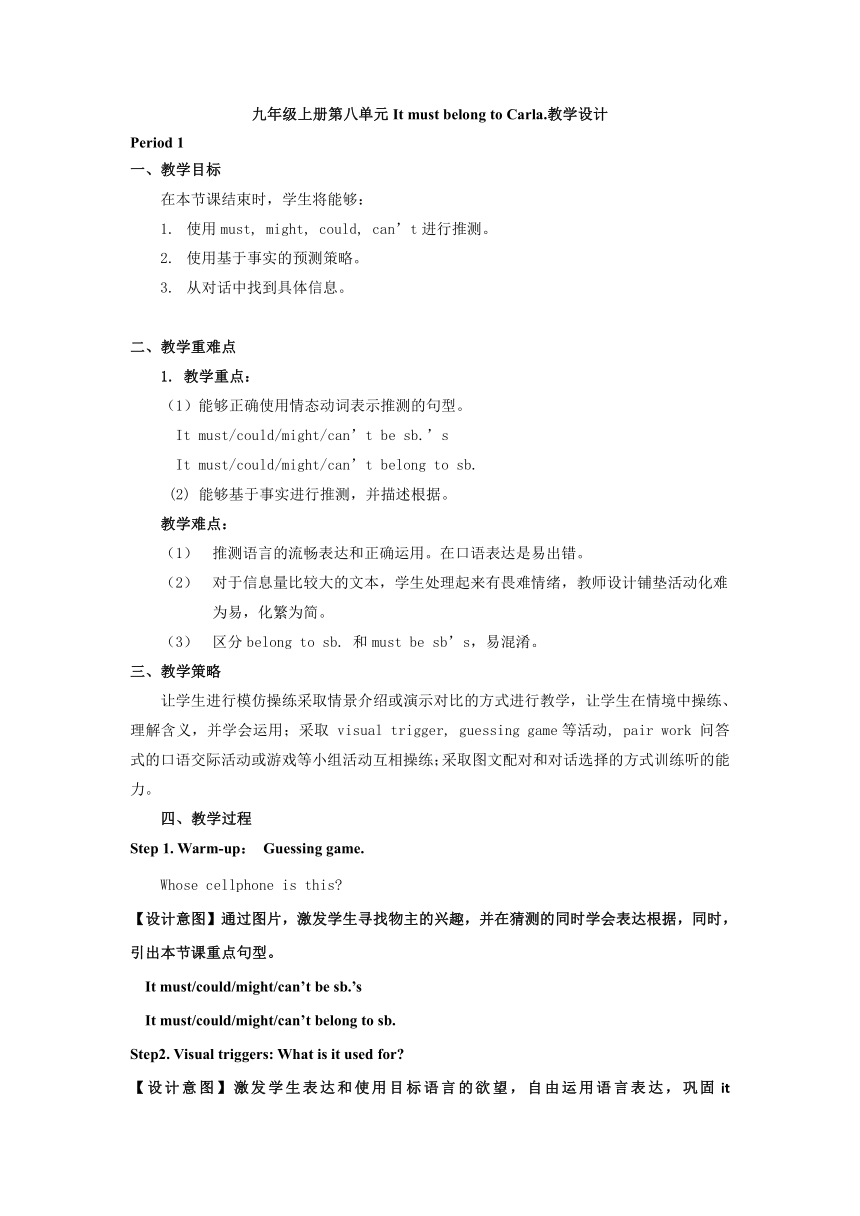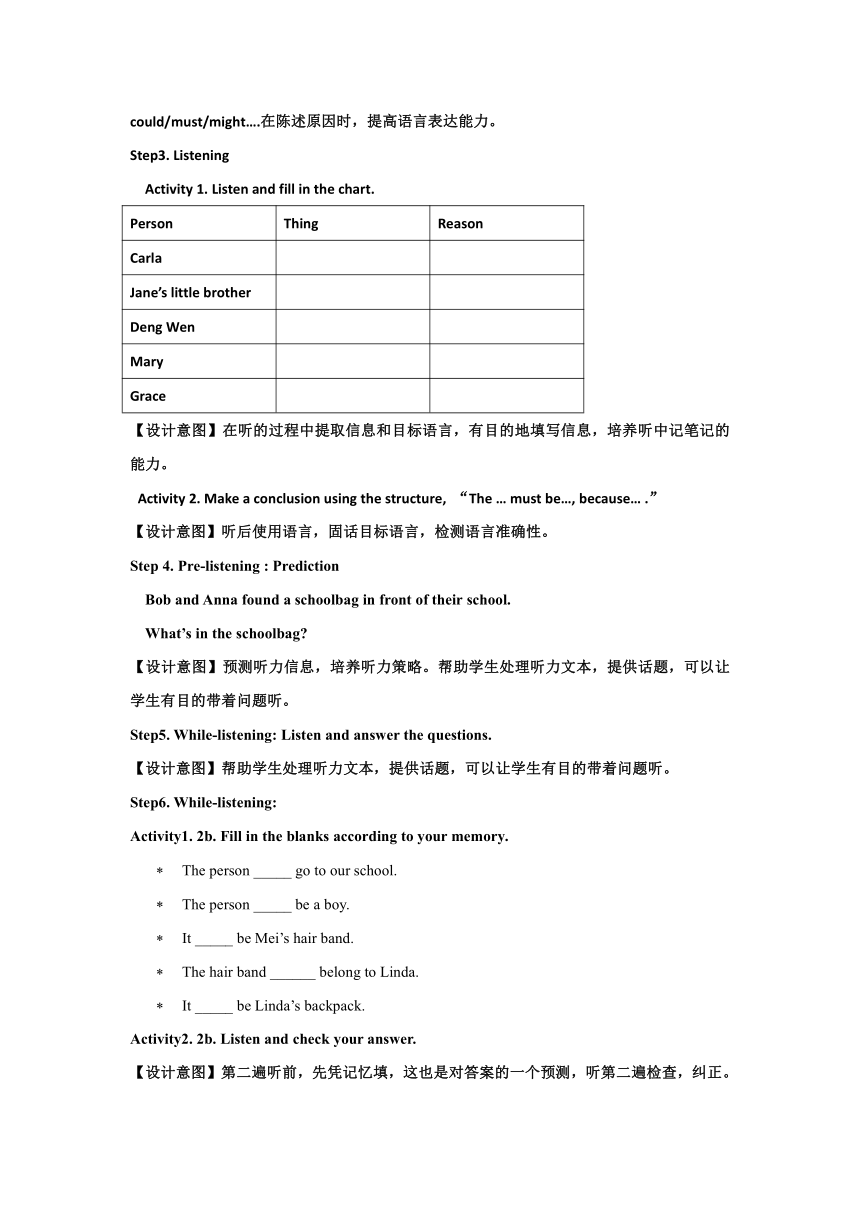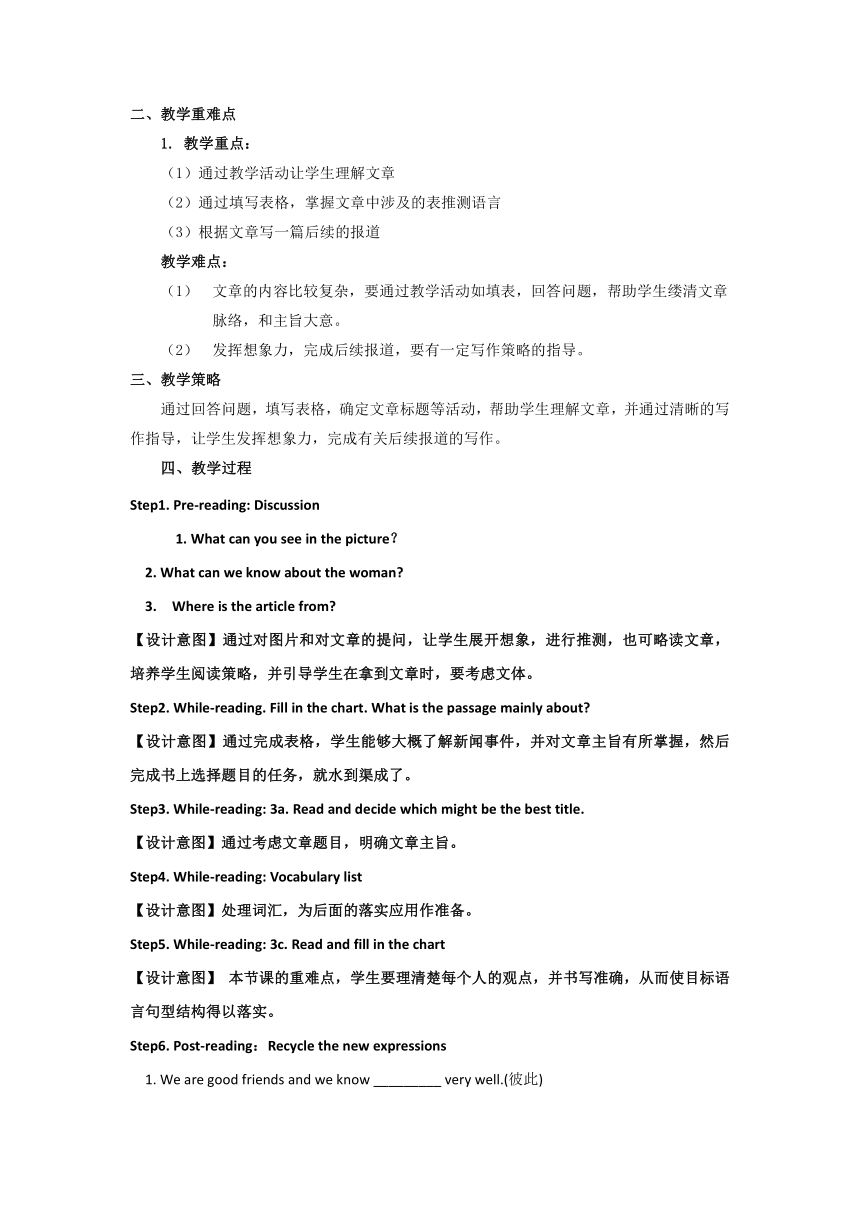人教新目标版英语九年级全Unit 8 It must belong to Carla.单元教学设计(4课时)
文档属性
| 名称 | 人教新目标版英语九年级全Unit 8 It must belong to Carla.单元教学设计(4课时) |  | |
| 格式 | zip | ||
| 文件大小 | 35.2KB | ||
| 资源类型 | 教案 | ||
| 版本资源 | 人教新目标(Go for it)版 | ||
| 科目 | 英语 | ||
| 更新时间 | 2021-08-02 00:02:37 | ||
图片预览




文档简介
九年级上册第八单元It
must
belong
to
Carla.教学设计
Period
1
一、教学目标
在本节课结束时,学生将能够:
使用must,
might,
could,
can’t进行推测。
使用基于事实的预测策略。
从对话中找到具体信息。
二、教学重难点
1.
教学重点:
(1)能够正确使用情态动词表示推测的句型。
It
must/could/might/can’t
be
sb.’s
It
must/could/might/can’t
belong
to
sb.
(2)
能够基于事实进行推测,并描述根据。
教学难点:
推测语言的流畅表达和正确运用。在口语表达是易出错。
对于信息量比较大的文本,学生处理起来有畏难情绪,教师设计铺垫活动化难为易,化繁为简。
区分belong
to
sb.
和must
be
sb’s,易混淆。
三、教学策略
让学生进行模仿操练采取情景介绍或演示对比的方式进行教学,让学生在情境中操练、理解含义,并学会运用;采取
visual
trigger,
guessing
game等活动,
pair
work
问答式的口语交际活动或游戏等小组活动互相操练;采取图文配对和对话选择的方式训练听的能力。
四、教学过程
Step
1.
Warm-up:
Guessing
game.
Whose
cellphone
is
this?
【设计意图】通过图片,激发学生寻找物主的兴趣,并在猜测的同时学会表达根据,同时,引出本节课重点句型。
It
must/could/might/can’t
be
sb.’s
It
must/could/might/can’t
belong
to
sb.
Step2.
Visual
triggers:
What
is
it
used
for?
【设计意图】激发学生表达和使用目标语言的欲望,自由运用语言表达,巩固it
could/must/might….在陈述原因时,提高语言表达能力。
Step3.
Listening
Activity
1.
Listen
and
fill
in
the
chart.
Person
Thing
Reason
Carla
Jane’s
little
brother
Deng
Wen
Mary
Grace
【设计意图】在听的过程中提取信息和目标语言,有目的地填写信息,培养听中记笔记的能力。
Activity
2.
Make
a
conclusion
using
the
structure,
“The
…
must
be…,
because…
.”
【设计意图】听后使用语言,固话目标语言,检测语言准确性。
Step
4.
Pre-listening
:
Prediction
Bob
and
Anna
found
a
schoolbag
in
front
of
their
school.
What’s
in
the
schoolbag?
【设计意图】预测听力信息,培养听力策略。帮助学生处理听力文本,提供话题,可以让学生有目的带着问题听。
Step5.
While-listening:
Listen
and
answer
the
questions.
【设计意图】帮助学生处理听力文本,提供话题,可以让学生有目的带着问题听。
Step6.
While-listening:
Activity1.
2b.
Fill
in
the
blanks
according
to
your
memory.
The
person
_____
go
to
our
school.
The
person
_____
be
a
boy.
It
_____
be
Mei’s
hair
band.
The
hair
band
______
belong
to
Linda.
It
_____
be
Linda’s
backpack.
Activity2.
2b.
Listen
and
check
your
answer.
【设计意图】第二遍听前,先凭记忆填,这也是对答案的一个预测,听第二遍检查,纠正。培养学生听力策略。
Step7.
Group
work:
You
and
your
friends
found
a
schoolbag
on
the
platform。
Try
to
make
a
conversation
to
find
out
the
owner.
【设计意图】为学生创设语境,真实演绎本单元话题——推测,既让学生使用了目标语言,也能让学生体会到语言应用的意义。教师需要在活动前准备好装有某个同学典型物品的书包。
Step8.
2d.
Read
the
article
and
answer
the
questions.
Check
answers.
Underline
some
key
sentences.
Linda:
Mom,
I’m
really
worried.
Mom:
Why?
What’s
wrong?
Linda:
I
can’t
find
my
schoolbag.
Mom:
Well,
where
did
you
last
put
it?
Linda:
I
can’t
remember!
I
attended
a
concert
yesterday
so
it
might
still
be
in
the
music
hall.
Mom:
Do
you
have
anything
valuable
in
your
schoolbag?
Linda:
No,
just
my
books,
my
pink
hair
band
and
some
tennis
balls.
Mom:
So
it
can’t
be
stolen.
Linda:
Oh,
wait!
I
went
to
a
picnic
after
the
concert.
I
remember
I
had
my
schoolbag
with
me
at
the
picnic.
Mom:
So
could
it
still
be
at
the
park?
Linda:
Yes.
I
left
early,
before
the
rest
of
my
friends.
I
think
somebody
must
have
picked
it
up.
I’ll
call
them
now
to
check
if
anybody
has
it.
【设计意图】书上2d
本身是个对话,但对话内容比较复杂,因此,用这样一个活动,能让学生准确理解对话信息。并能迁移到生活中来。
Period2
一、教学目标
在本节课结束时,学生将能够:
为文章选择题目
用文章中的信息完成表格
为文章写一个后续报道
二、教学重难点
1.
教学重点:
(1)通过教学活动让学生理解文章
(2)通过填写表格,掌握文章中涉及的表推测语言
(3)根据文章写一篇后续的报道
教学难点:
文章的内容比较复杂,要通过教学活动如填表,回答问题,帮助学生缕清文章脉络,和主旨大意。
发挥想象力,完成后续报道,要有一定写作策略的指导。
三、教学策略
通过回答问题,填写表格,确定文章标题等活动,帮助学生理解文章,并通过清晰的写作指导,让学生发挥想象力,完成有关后续报道的写作。
四、教学过程
Step1.
Pre-reading:
Discussion
1.
What
can
you
see
in
the
picture?
2.
What
can
we
know
about
the
woman?
3.
Where
is
the
article
from?
【设计意图】通过对图片和对文章的提问,让学生展开想象,进行推测,也可略读文章,培养学生阅读策略,并引导学生在拿到文章时,要考虑文体。
Step2.
While-reading.
Fill
in
the
chart.
What
is
the
passage
mainly
about?
【设计意图】通过完成表格,学生能够大概了解新闻事件,并对文章主旨有所掌握,然后完成书上选择题目的任务,就水到渠成了。
Step3.
While-reading:
3a.
Read
and
decide
which
might
be
the
best
title.
【设计意图】通过考虑文章题目,明确文章主旨。
Step4.
While-reading:
Vocabulary
list
【设计意图】处理词汇,为后面的落实应用作准备。
Step5.
While-reading:
3c.
Read
and
fill
in
the
chart
【设计意图】
本节课的重难点,学生要理清楚每个人的观点,并书写准确,从而使目标语言句型结构得以落实。
Step6.
Post-reading:Recycle
the
new
expressions
1.
We
are
good
friends
and
we
know
_________
very
well.(彼此)
2.It
__________
very
quiet,
but
now
it’s
noisy.(曾经)
3.
My
friends
and
I
think
it
must
be
teenagers
___________(have
fun)
4.
I
think
it’s
_____
big
______
be
a
dog.
5.
There
must
be
something
_________(visit)the
homes
in
our
______________.(附近,邻里)
【设计意图】提供新的语境,落实文本中的语言结构和表达,使所学得以迁移。
Step7.
Post-reading:
Group
Work:
Discussion发挥想象,设计故事解决的结尾。
What
do
you
think
the
noises
could
be?
List
all
your
ideas.
See
who
in
your
group
can
come
up
with
the
most
imaginative
explanation.
What
could
the
noises
be?
Why
do
you
think
so?
【设计意图】培养逻辑能力和创造力,使用目标语言,为最后的写作作铺垫。
Step8.
Writing:
finish
the
article
according
to
the
newspaper
headline.
1.
What
is
the
background
information
about
the
mystery?
2.
How
was
the
mystery
solved?
3.
How
do
the
people
in
the
neighborhood
now
feel?
【设计意图】根据所给文章题目和写作指导,完成后续的一个报道。可作为家庭作业。
Period
3
一、教学目标
在本节课结束时,学生将能够:
使用现在进行时表推测的语言结构“might/could/must
be
doing”
根据上下文语境进行推测
区别“must,
might,
could
can’t”情态动词表推测的可能性。
二、教学重难点
1.
教学重点:
(1)
must,
might,
could,
can’t
be
doing的用法
(2)
区别“must,
might,
could
can’t”情态动词表推测的可能性。
(3)
在语言实践中应用
教学难点:
准确填写目标语言,区分“must,
might,
could,
can’t”
在实际的语言应用中,表达准确。
三、教学策略
让学生在情境中操练、理解含义,并学会运用;用例子,定义,图示明确“must,
might,
could,
can’t”的区别及用法,采取fill
in
the
blanks,
multiple
choice
的语法实践,group
work的口语交际活动互相操练。
四、教学过程
Step1.
Warm
up:Guessing
Game
What
is
she
doing?
She
might
be
singing.
【设计意图】通过guessing
game的游戏,引出目标语言“might/could/
must
be
doing”,让学生在情境中使用语言。
Step2.
Language
Focus
【设计意图】明确目标语言的功能
Step3.
Pre-listening
【设计意图】描述图片,编故事,使用目标语言。
Step4.
While-listening
Activity1.
1b.
Listen
and
number
the
pictures.
Activity2.
1c.
Listen
and
fill
in
the
chart.
【设计意图】理解听力文本,强化目标语言,感知语言的推测功能。
Step5.
Post-listening:
Retell
the
story
【设计意图】使用目标语言
Step6.
Visual
Triggers:
Where
can
you
find
it?
It
could
be
found
in…
【设计意图】激发学生思维,复习使用目标语言。
Step7.
4a.
Fill
in
the
blanks
【设计意图】通过实践,让学生体验“must,
might,
could,
can’t”的区别,对前面课时的复习和检验,也是在实践中产生问题,之后解决问题的关键。
Step8.
4b.
Complete
these
responses.
【设计意图】锻炼学生逻辑推理能力,体验本单元目标语言的语法功能。
Step9.
Language
Focus:
belong
to的用法,must,
might,
could,
can’t,的区别
【设计意图】通过举例,对比等方法,帮助学生理清目标语言的使用方法。
Step10.
Practice
Activity1.
Multiple
choices
Activity2.
Fill
in
the
blanks.
Activity3.
Self-check-1
【设计意图】有针对性的进行训练实践,体会language
focus的讲解。
Step11.
Self-check-2
Look
at
the
chart
and
write
sentences
for
the
things
below.
【设计意图】这个活动是对目标语言的灵活应用,既需要学生的语言能力,也需要学生的逻辑思维能力。
Period4
一、教学目标
在本节课结束时,学生将能够:
明确连接词的使用目的
了解世界之谜
二、教学重难点
1.
教学重点:
(1)阅读策略,连接词的使用
(2)目标语言“might/could/must
be
doing”
(3)文化背景知识
教学难点:
对“巨石”的文化背景的了解。
文章的内容比较复杂,要通过教学活动如填表,回答问题,帮助学生缕清文章脉络,和主旨大意。
世界地理文化知识的涉猎和补充
三、教学策略
通过回答问题,填写表格,连线等活动,帮助学生理解文章,掌握连接词的使用目的,并通过图片,背景知识等介绍,拓展学生文化视野。
四、教学过程
Step1.
Pre-reading:
quick
guide-Stonehenge
【设计意图】提供文化背景知识,简要介绍“巨石阵”。
Step2.
While-reading:
Match
the
subtitle
with
each
paragraph
【设计意图】第一篇略读,大体上了解文章,并且能够找出匹配的小标题
Step3.
While-reading:
Read
paragraph
1
Brief
Introduction
of
Stonehenge
读第一段完成填空
【设计意图】第二篇精读第一段,掌握具体信息。
Step4.
While-reading:
Read
paragraph
2-3
and
complete
the
chart.读第2-3段,完成表格。
【设计意图】精读第2段和第3段,找出人们关于巨石阵曾经被利用来做什么的不同看法。
Step5.
While-reading:
Read
paragraph
2-4.
Read
the
2-4
and
find
out
the
mysteries.
整体把握结构。
【设计意图】精读第2到4段,找出人们关于巨石阵之谜。整体把握文章脉络。
Step6.Post-reading:
Finish
the
mind
map
of
the
article.
【设计意图】完成表格,检测文章掌握情况,便于复述。
Step7.
While-reading:
2a.
Match
each
linking
word
or
phrase
with
its
purpose.
2c.Complete
the
sentences
using
the
linking
words
【设计意图】通过连线,找出连接词在文章中的作用,完成句子后,体会连接词的用法,培养阅读策略。
Step8.
Post-reading:
Group
Discussion
Can
you
think
of
any
other
mysteries,
either
in
China
or
another
part
of
the
world,
that
are
similar
to
Stonehenge?
Show
the
pictures
about
the
mysteries
in
the
world.
【设计意图】学生交流,丰富文化视野,拓展背景知识,为后面的写作积攒素材。
Step9.
Homework:Writing:A
mystery
you
want
to
introduce
What
mystery
you
want
to
introduce?
What
is
mysterious
about
it?
What
attracts
the
visitors
to
go
there?
【设计意图】按照中考写作题型设计,并给出范文。文章偏难,有困难的学生可作为写作阅读的补充材料。
must
belong
to
Carla.教学设计
Period
1
一、教学目标
在本节课结束时,学生将能够:
使用must,
might,
could,
can’t进行推测。
使用基于事实的预测策略。
从对话中找到具体信息。
二、教学重难点
1.
教学重点:
(1)能够正确使用情态动词表示推测的句型。
It
must/could/might/can’t
be
sb.’s
It
must/could/might/can’t
belong
to
sb.
(2)
能够基于事实进行推测,并描述根据。
教学难点:
推测语言的流畅表达和正确运用。在口语表达是易出错。
对于信息量比较大的文本,学生处理起来有畏难情绪,教师设计铺垫活动化难为易,化繁为简。
区分belong
to
sb.
和must
be
sb’s,易混淆。
三、教学策略
让学生进行模仿操练采取情景介绍或演示对比的方式进行教学,让学生在情境中操练、理解含义,并学会运用;采取
visual
trigger,
guessing
game等活动,
pair
work
问答式的口语交际活动或游戏等小组活动互相操练;采取图文配对和对话选择的方式训练听的能力。
四、教学过程
Step
1.
Warm-up:
Guessing
game.
Whose
cellphone
is
this?
【设计意图】通过图片,激发学生寻找物主的兴趣,并在猜测的同时学会表达根据,同时,引出本节课重点句型。
It
must/could/might/can’t
be
sb.’s
It
must/could/might/can’t
belong
to
sb.
Step2.
Visual
triggers:
What
is
it
used
for?
【设计意图】激发学生表达和使用目标语言的欲望,自由运用语言表达,巩固it
could/must/might….在陈述原因时,提高语言表达能力。
Step3.
Listening
Activity
1.
Listen
and
fill
in
the
chart.
Person
Thing
Reason
Carla
Jane’s
little
brother
Deng
Wen
Mary
Grace
【设计意图】在听的过程中提取信息和目标语言,有目的地填写信息,培养听中记笔记的能力。
Activity
2.
Make
a
conclusion
using
the
structure,
“The
…
must
be…,
because…
.”
【设计意图】听后使用语言,固话目标语言,检测语言准确性。
Step
4.
Pre-listening
:
Prediction
Bob
and
Anna
found
a
schoolbag
in
front
of
their
school.
What’s
in
the
schoolbag?
【设计意图】预测听力信息,培养听力策略。帮助学生处理听力文本,提供话题,可以让学生有目的带着问题听。
Step5.
While-listening:
Listen
and
answer
the
questions.
【设计意图】帮助学生处理听力文本,提供话题,可以让学生有目的带着问题听。
Step6.
While-listening:
Activity1.
2b.
Fill
in
the
blanks
according
to
your
memory.
The
person
_____
go
to
our
school.
The
person
_____
be
a
boy.
It
_____
be
Mei’s
hair
band.
The
hair
band
______
belong
to
Linda.
It
_____
be
Linda’s
backpack.
Activity2.
2b.
Listen
and
check
your
answer.
【设计意图】第二遍听前,先凭记忆填,这也是对答案的一个预测,听第二遍检查,纠正。培养学生听力策略。
Step7.
Group
work:
You
and
your
friends
found
a
schoolbag
on
the
platform。
Try
to
make
a
conversation
to
find
out
the
owner.
【设计意图】为学生创设语境,真实演绎本单元话题——推测,既让学生使用了目标语言,也能让学生体会到语言应用的意义。教师需要在活动前准备好装有某个同学典型物品的书包。
Step8.
2d.
Read
the
article
and
answer
the
questions.
Check
answers.
Underline
some
key
sentences.
Linda:
Mom,
I’m
really
worried.
Mom:
Why?
What’s
wrong?
Linda:
I
can’t
find
my
schoolbag.
Mom:
Well,
where
did
you
last
put
it?
Linda:
I
can’t
remember!
I
attended
a
concert
yesterday
so
it
might
still
be
in
the
music
hall.
Mom:
Do
you
have
anything
valuable
in
your
schoolbag?
Linda:
No,
just
my
books,
my
pink
hair
band
and
some
tennis
balls.
Mom:
So
it
can’t
be
stolen.
Linda:
Oh,
wait!
I
went
to
a
picnic
after
the
concert.
I
remember
I
had
my
schoolbag
with
me
at
the
picnic.
Mom:
So
could
it
still
be
at
the
park?
Linda:
Yes.
I
left
early,
before
the
rest
of
my
friends.
I
think
somebody
must
have
picked
it
up.
I’ll
call
them
now
to
check
if
anybody
has
it.
【设计意图】书上2d
本身是个对话,但对话内容比较复杂,因此,用这样一个活动,能让学生准确理解对话信息。并能迁移到生活中来。
Period2
一、教学目标
在本节课结束时,学生将能够:
为文章选择题目
用文章中的信息完成表格
为文章写一个后续报道
二、教学重难点
1.
教学重点:
(1)通过教学活动让学生理解文章
(2)通过填写表格,掌握文章中涉及的表推测语言
(3)根据文章写一篇后续的报道
教学难点:
文章的内容比较复杂,要通过教学活动如填表,回答问题,帮助学生缕清文章脉络,和主旨大意。
发挥想象力,完成后续报道,要有一定写作策略的指导。
三、教学策略
通过回答问题,填写表格,确定文章标题等活动,帮助学生理解文章,并通过清晰的写作指导,让学生发挥想象力,完成有关后续报道的写作。
四、教学过程
Step1.
Pre-reading:
Discussion
1.
What
can
you
see
in
the
picture?
2.
What
can
we
know
about
the
woman?
3.
Where
is
the
article
from?
【设计意图】通过对图片和对文章的提问,让学生展开想象,进行推测,也可略读文章,培养学生阅读策略,并引导学生在拿到文章时,要考虑文体。
Step2.
While-reading.
Fill
in
the
chart.
What
is
the
passage
mainly
about?
【设计意图】通过完成表格,学生能够大概了解新闻事件,并对文章主旨有所掌握,然后完成书上选择题目的任务,就水到渠成了。
Step3.
While-reading:
3a.
Read
and
decide
which
might
be
the
best
title.
【设计意图】通过考虑文章题目,明确文章主旨。
Step4.
While-reading:
Vocabulary
list
【设计意图】处理词汇,为后面的落实应用作准备。
Step5.
While-reading:
3c.
Read
and
fill
in
the
chart
【设计意图】
本节课的重难点,学生要理清楚每个人的观点,并书写准确,从而使目标语言句型结构得以落实。
Step6.
Post-reading:Recycle
the
new
expressions
1.
We
are
good
friends
and
we
know
_________
very
well.(彼此)
2.It
__________
very
quiet,
but
now
it’s
noisy.(曾经)
3.
My
friends
and
I
think
it
must
be
teenagers
___________(have
fun)
4.
I
think
it’s
_____
big
______
be
a
dog.
5.
There
must
be
something
_________(visit)the
homes
in
our
______________.(附近,邻里)
【设计意图】提供新的语境,落实文本中的语言结构和表达,使所学得以迁移。
Step7.
Post-reading:
Group
Work:
Discussion发挥想象,设计故事解决的结尾。
What
do
you
think
the
noises
could
be?
List
all
your
ideas.
See
who
in
your
group
can
come
up
with
the
most
imaginative
explanation.
What
could
the
noises
be?
Why
do
you
think
so?
【设计意图】培养逻辑能力和创造力,使用目标语言,为最后的写作作铺垫。
Step8.
Writing:
finish
the
article
according
to
the
newspaper
headline.
1.
What
is
the
background
information
about
the
mystery?
2.
How
was
the
mystery
solved?
3.
How
do
the
people
in
the
neighborhood
now
feel?
【设计意图】根据所给文章题目和写作指导,完成后续的一个报道。可作为家庭作业。
Period
3
一、教学目标
在本节课结束时,学生将能够:
使用现在进行时表推测的语言结构“might/could/must
be
doing”
根据上下文语境进行推测
区别“must,
might,
could
can’t”情态动词表推测的可能性。
二、教学重难点
1.
教学重点:
(1)
must,
might,
could,
can’t
be
doing的用法
(2)
区别“must,
might,
could
can’t”情态动词表推测的可能性。
(3)
在语言实践中应用
教学难点:
准确填写目标语言,区分“must,
might,
could,
can’t”
在实际的语言应用中,表达准确。
三、教学策略
让学生在情境中操练、理解含义,并学会运用;用例子,定义,图示明确“must,
might,
could,
can’t”的区别及用法,采取fill
in
the
blanks,
multiple
choice
的语法实践,group
work的口语交际活动互相操练。
四、教学过程
Step1.
Warm
up:Guessing
Game
What
is
she
doing?
She
might
be
singing.
【设计意图】通过guessing
game的游戏,引出目标语言“might/could/
must
be
doing”,让学生在情境中使用语言。
Step2.
Language
Focus
【设计意图】明确目标语言的功能
Step3.
Pre-listening
【设计意图】描述图片,编故事,使用目标语言。
Step4.
While-listening
Activity1.
1b.
Listen
and
number
the
pictures.
Activity2.
1c.
Listen
and
fill
in
the
chart.
【设计意图】理解听力文本,强化目标语言,感知语言的推测功能。
Step5.
Post-listening:
Retell
the
story
【设计意图】使用目标语言
Step6.
Visual
Triggers:
Where
can
you
find
it?
It
could
be
found
in…
【设计意图】激发学生思维,复习使用目标语言。
Step7.
4a.
Fill
in
the
blanks
【设计意图】通过实践,让学生体验“must,
might,
could,
can’t”的区别,对前面课时的复习和检验,也是在实践中产生问题,之后解决问题的关键。
Step8.
4b.
Complete
these
responses.
【设计意图】锻炼学生逻辑推理能力,体验本单元目标语言的语法功能。
Step9.
Language
Focus:
belong
to的用法,must,
might,
could,
can’t,的区别
【设计意图】通过举例,对比等方法,帮助学生理清目标语言的使用方法。
Step10.
Practice
Activity1.
Multiple
choices
Activity2.
Fill
in
the
blanks.
Activity3.
Self-check-1
【设计意图】有针对性的进行训练实践,体会language
focus的讲解。
Step11.
Self-check-2
Look
at
the
chart
and
write
sentences
for
the
things
below.
【设计意图】这个活动是对目标语言的灵活应用,既需要学生的语言能力,也需要学生的逻辑思维能力。
Period4
一、教学目标
在本节课结束时,学生将能够:
明确连接词的使用目的
了解世界之谜
二、教学重难点
1.
教学重点:
(1)阅读策略,连接词的使用
(2)目标语言“might/could/must
be
doing”
(3)文化背景知识
教学难点:
对“巨石”的文化背景的了解。
文章的内容比较复杂,要通过教学活动如填表,回答问题,帮助学生缕清文章脉络,和主旨大意。
世界地理文化知识的涉猎和补充
三、教学策略
通过回答问题,填写表格,连线等活动,帮助学生理解文章,掌握连接词的使用目的,并通过图片,背景知识等介绍,拓展学生文化视野。
四、教学过程
Step1.
Pre-reading:
quick
guide-Stonehenge
【设计意图】提供文化背景知识,简要介绍“巨石阵”。
Step2.
While-reading:
Match
the
subtitle
with
each
paragraph
【设计意图】第一篇略读,大体上了解文章,并且能够找出匹配的小标题
Step3.
While-reading:
Read
paragraph
1
Brief
Introduction
of
Stonehenge
读第一段完成填空
【设计意图】第二篇精读第一段,掌握具体信息。
Step4.
While-reading:
Read
paragraph
2-3
and
complete
the
chart.读第2-3段,完成表格。
【设计意图】精读第2段和第3段,找出人们关于巨石阵曾经被利用来做什么的不同看法。
Step5.
While-reading:
Read
paragraph
2-4.
Read
the
2-4
and
find
out
the
mysteries.
整体把握结构。
【设计意图】精读第2到4段,找出人们关于巨石阵之谜。整体把握文章脉络。
Step6.Post-reading:
Finish
the
mind
map
of
the
article.
【设计意图】完成表格,检测文章掌握情况,便于复述。
Step7.
While-reading:
2a.
Match
each
linking
word
or
phrase
with
its
purpose.
2c.Complete
the
sentences
using
the
linking
words
【设计意图】通过连线,找出连接词在文章中的作用,完成句子后,体会连接词的用法,培养阅读策略。
Step8.
Post-reading:
Group
Discussion
Can
you
think
of
any
other
mysteries,
either
in
China
or
another
part
of
the
world,
that
are
similar
to
Stonehenge?
Show
the
pictures
about
the
mysteries
in
the
world.
【设计意图】学生交流,丰富文化视野,拓展背景知识,为后面的写作积攒素材。
Step9.
Homework:Writing:A
mystery
you
want
to
introduce
What
mystery
you
want
to
introduce?
What
is
mysterious
about
it?
What
attracts
the
visitors
to
go
there?
【设计意图】按照中考写作题型设计,并给出范文。文章偏难,有困难的学生可作为写作阅读的补充材料。
同课章节目录
- Unit 1 How can we become good learners.
- Section A
- Section B
- Unit 2 I think that mooncakes are delicious!
- Section A
- Section B
- Unit 3 Could you please tell me where the restroom
- Section A
- Section B
- Unit 4 I used to be afraid of the dark.
- Section A
- Section B
- Unit 5 What are the shirts made of?
- Section A
- Section B
- Review of Units 1-5
- Unit 6 When was it invented?
- Section A
- Section B
- Unit 7 Teenagers should be allowed to choose their
- Section A
- Section B
- Unit 8 It must belong to Carla.
- Section A
- Section B
- Unit 9 I like music that I can dance to.
- Section A
- Section B
- Unit 10 You're supposed to shake hands.
- Section A
- Section B
- Review of Units 6-10
- Unit 11 Sad movies make me cry.
- Section A
- Section B
- Unit 12 Life is full of the unexpected
- Section A
- Section B
- Unit 13 We're trying to save the earth!
- Section A
- Section B
- Unit 14 I remember meeting all of you in Grade 7.
- Section A
- Section B
- Review of Units 11-14
